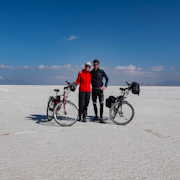 |
Etappe 2022/06 [SA006] | ||
|
Pozo Colorado - Salina Grandes - Pozo Colorado |
|||
| 28 km / 17 mi | |||
| 50 Hm (garmin edge 1000) | |||
Cycling the Salinas Grandes of Argentina. |
|
We start our tour to the Salinas Grandes today with light luggage only; the heavy equipment stays in the accommodation until tomorrow. The only heavy duty equipment we carry with us are our upgraded cycling glasses: while cycling on the altiplano and especially on the Salinas Grandes, we will wear special cycling glasses that offer increased protection against UV radiation. Fun fact: in Germany we are not allowed to drive wearing these glasses. Exactly the stuff we need up here. |
 After surviving the terrible corrugated washboard road yesterday, we cycle today directly towards the Salinas Grandes using lanes we find on the ground. This saves us the rough road and after a short distance we are on the salt! |
 Wow! The surface is exactly as described by experienced long-distance cyclists: flat. So flat so that it couldn't be any easier to cycle on it. There are small razor edges at the boundaries of the hexagon-shaped salt clods which immediately gives way under the weight of the tire and offers no noticeable resistance. What a great experience to drive over the crystallized hexagonal salt floes is incredible: visually there is a stark discrepancy between the blue sky and the inhospitable salt desert that stretches to the horizon, which does not allow for any warm tone from the yellow or red range of the color spectrum. Nothing compares to the easy cycling over the salt crust, which is only hindered by the uncomfortable wind. |
|
Riding a bicycle across the Salinas Grandes is one of the most beautiful experiences we had on our bikes. |
 The Salinas Grandes have an area of 212 square kilometers (82 square miles) and are located at an altitude of around 3500m / 11,500 ft. Here, on the part north of Ruta 52, access is not regulated by anyone and we can move around freely. |
|
Access to the portion south of the Purmamarca-Susques road is controlled by the local indigenous populations and you are expected to pay an entrance fee at the visitor center to enter the salt. Living from livestock and subsistence farming the local indigenious popilation use tourism as an additional source of income. In the last few days we have seen many heavy trucks transporting equipment for the mines on the Altiplano. The conflict between the mines that use a lot of water to extract metals like Lithium for our smartphones on one side and the peoples who have been living there for centuries and for whom groundwater is the basis of life on the other side is obvious. |
|
At the visitors center we book a trip to one of the so-called eyes of the salt. This is what the open patches of saline that are not closed by a salt crust are called. The guides here are prepared for visitors in cars or minibuses and usually a small number of cars are bundled together to form a group. A guide sits in the passenger seat of one of these vehicles and leads the group of vehicles. We and our bikes are assigned to the next convoy of vehicles and off we go. Unfortunately, the guide piloting the first vehicle has no understanding of the speed we and our bicyclescan do, so we can barely keep up. |
|
The open water eyes of the Salinas Grandes are worth every effort: the blue of the sky is complemented by the blue of the salt water. Apart from the wind blowing around our ears, there is an incredible silence up here. The journey back from the waterhole to the visitor center at the main road is even more strenuous for us: on our way back we experience strong headwinds and unfortunally the driver of the leading vehicle doesn't seem to feel the strong headwind nearly as much as we do on our bicycles. |
|
Close to the asphalt street R52, salt is extracted using traditional methods. In several places we can see the salt crust removed and the water is allowed to crystallize in crystallization pools. The salt is left in these pools to "mature" for 12 month. After the evaporation of the water the salt is harvested by taking it out of the pools and deposited on the side to dry for some more weeks. The harvested salt ist sold as table salt. |
|
After a full day out on the Salinas Grandes, we cycle back to our accommodation in Pozo Colorado the same way we came. At one point where we feel unobserved, we enter the northern part of the Salinas Grandes and cycle north until we reach the end of the Saline. There follow a track we find on the ground back to the washbord road. We make a mental note about the location of the junction to make sure that we will find the same track tomorrow morning. With our heavy luggage, we certainly don't want to follow the washboard road around the Saline. |










